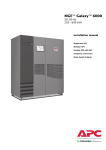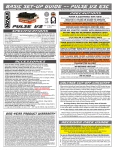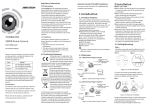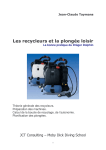Download Better Quick Dually Operating instructions
Transcript
OPERATING INSTRUCTIONS Part #1660 DUALLY DUAL-PROFILE The Novak Dually is a microprocessor-based high-frequency ESC (Electronic Speed Control) using advanced components and the best HYPERFET III transistors for high performance. The Dually Dual-Profile ESC gives you extra flexibility with two user-selectable throttle profiles for optimum control of both modified and stock motors with a single speed control. The Dually also has Novak’s CLC III current limiter that delivers extra smooth control, and is adjustable from 20 to 120 amps or completely off for full power. With Novak’s exclusive Polar Drive Technology™, and Digital Anti-Glitch Circuitry™, the Dually runs faster, longer, and smoother than other speed controls. Set-up is quick and easy with Novak’s original One-Touch Set-Up™, and Radio Priority Circuity™ maintains complete control of the vehicle’s steering servo even after the battery pack has dumped and can no longer run the motor. The Dually’s heavy-duty BEC (Battery Eliminator Circuit) handles today’s high power servos. Other features include the Novak Input Plug System™ for compatibility with all major radio systems, Thermal Overload Protection, and purple anodized Micro Fin™ heat sinks for optimum cooling and performance. SPECIFICATIONS Input Voltage Case Width Case Depth Case Height Weight (w/o heat sinks) On-Resistance @ Transistors Rated Current Braking Current BEC Voltage / Current Wire Size (Battery/Motor) Wire Length (Battery/Motor) Signal Harness Length Transistor Type Current Limiter Range Throttle Profiles PWM Drive Frequency Minimum Drive (% Full Drive) 4-7 cells (1.2 volts DC/cell) 1.63 inches [4.14 cm] 1.72 inches [4.37 cm] 0.65 inch [1.65 cm] 2.10 ounces [59.53 g] 0.0007 Ω @ 25°C transistor 400 amps junction temp. 100 amps 6.0 volts DC / 3.0 amps 14 gauge 9 inches [22.8 cm] 8 inches [20.3 cm] HYPERFET III 20 to 100 amps / OFF (1) Modified (2) Stock (1) 7.8 kHz (2) 1.0 kHz (1) 3 % (2) 6 % ACCESSORIES PRECAUTIONS RADIO INTERFERENCE MOTOR CAPACITORS The high frequency switching operation of electronic speed controls can generate radio interference. Here are some common causes of radio interference problems: The added cooling that is provided by heat sinks will result in increased efficiency and optimum speed control operation. A replacement Heat Sink Set for the Dually is available as Novak kit #5403. Heat sinks are required with the Dually, and all applications should allow adequate air circulation through the heat sink’s fins to provide proper speed control cooling. • READ INSTRUCTIONS CAREFULLY BEFORE USING! • WATER & ELECTRONICS DON’T MIX! Do not operate model in or around water. Never allow water, moisture, or other foreign materials to get inside the ESC. • 4 to 7 CELLS ONLY Never use more than 7 cells (8.4 volts DC) in the main battery pack. • MOTOR CAPACITORS REQUIRED Three 0.1µF (50V) ceramic capacitors must be properly installed on every motor to prevent radio interference. • NO REVERSE VOLTAGE! Reverse battery polarity can damage speed control––Disconnect battery immediately. • DON’T LET TRANSISTOR TABS TOUCH Never allow the two transistor tab banks to touch each other or any exposed metal, as this will create a short circuit and damage the speed control. • DISCONNECT THE BATTERIES Always disconnect the battery pack from the speed control when not in use. • TRANSMITTER ON FIRST Always turn on the power of your transmitter first so that you will have control of the radio equipment when you turn on the speed control. • DON’T GET BURNT! Transistor tabs can get hot, so be careful not to touch them until they cool. If transistor tabs get extremely hot use optional heat sinks. • INSULATE WIRES Always insulate exposed wiring with heat shrink tubing to prevent short circuits. STEP 1 STEP 2 STEP 3 Included with the Dually ESC is the Novak Input Plug SystemTM to convert the Futaba J style signal harness to be compatible with Sanwa, KO, Kyosho, JR, and Hitec radios. Refer to Figures 1 through 3 to convert plug. 1. DETERMINE THE BEST ESC MOUNTING LOCATION Refer to Set-Up photo on back To prevent radio interference problems, you must have three 0.1µF capacitors properly installed on every motor. Included with the Dually speed controls are three 0.1µF (50v) capacitors for one motor. Additional 0.1µF (50V) capacitors are also available in Novak kit #5620. Refer to Step 3 for motor capacitor installation instructions. SCHOTTKY DIODES The Dually has an internal Schottky diode, and does not require an external Schottky diode. However, an optional external Schottky diode can also be added for increased performance. Refer to Step 3 for installation instructions. Additional Schottky diodes are available in Novak kit #5640. HEAT SINKS CHANGING THE INPUT PLUG MOUNTING INSTRUCTIONS KO Kyosho (KYO) JR/Hitec/AirZ FIGURE 1 With a small standard screwdriver, press on each of the three metal prongs until the wires are easy to remove. Remove wires. The speed control should be positioned away from the receiver and antenna as shown in set-up photo on back page. Choose a mounting position that will keep power wires away from the receiver and antenna. Choose a position that will provide maximum airflow through the transistor tabs or heat sinks to allow for proper cooling. Use the included double-sided tape to mount ESC. 3. INSTALL THE ON/OFF SWITCH Determine a convenient place to mount the switch where it will be easy to get to. Mount switch using a piece of double-sided tape or with a screw through the hole in the base of the switch housing. 4. INSTALL THE RECEIVER AND ANTENNA FIGURE 2 With the screwdriver, carefully lift each of the metal locking tabs to the angle shown. Mount receiver as far from ESC, motor, power wires, battery, and servo as possible. These components all emit radio noise when the throttle is being applied. On graphite or aluminum, it may help to place the receiver on edge with the crystal and antenna as far above the chassis as possible. Mount the antenna close to the receiver and trail any excess wire off the top of the antenna mast. Cutting or coiling excess wire will reduce radio range. HOOK-UP INSTRUCTIONS 1. INSTALL MOTOR CAPACITORS (Sanwa plug shown) The locking tab must not extend outside the plastic plug housing. WHT = White wire terminal (signal) BLK = Black wire terminal (negative) RED = Red wire terminal (positive) CAUTION Improper installation of these wires may cause damage to the receiver, servo, and speed control. • MOTOR BRUSHES WORN As motor brushes continue to wear, excessive motor noise will be generated. To avoid radio interference, worn motor brushes should be replaced. The motor commutator may also need to be cleaned or trued and can be machined to help the motor run more efficiently. 2. CONNECT SPEED CONTROL TO THE RECEIVER After the proper input plug plastic has been installed to match the receiver (Refer to Step 1), plug the speed control into the THROTTLE CHANNEL of the receiver. 3. CONNECT SPEED CONTROL TO THE BATTERY PACK Cut the BLACK wire of speed control to the desired length and strip about 1/8”-1/4” of insulation off the end. Solder to the negative side of a completely charged 4 to 7 cell battery pack (1.2 volts DC/cell). Strip a short section of the insulation (1/4”-3/8”) from the middle section of the speed control’s RED wire where it will attach to positive of the battery pack. Solder the stripped middle section of the RED wire to positive of the battery pack. 4. CONNECT SPEED CONTROL TO THE MOTOR Cut the RED wire (after battery pack connection) to the desired length and strip about 1/8”-1/4” of insulation off the end. Solder to the positive motor tab. Cut the BLUE wire of speed control to desired length and strip about 1/8”-1/4” of insulation off the end. Solder to the negative tab of the motor. TIP: Twisting the BLUE & RED motor wires one or two times around each other as they go to motor can help reduce any radio noise that may be emitted from the power wires. 5. USE OF OPTIONAL EXTERNAL SCHOTTKY DIODE Solder the lead CLOSEST to the silver stripe on the body of the Schottky diode to the POSITIVE (+) motor tab. Solder the lead OPPOSITE the silver stripe on the body of the Schottky to the NEGATIVE (–) motor tab. STEP 3 FIGURE 3 Insert each pin into the correct plug slot. Each pin should "click" into place. • RECEIVER/ANTENNA INCORRECTLY MOUNTED The receiver and antenna should be mounted as far from the motor, power wires, battery, and servo as possible, as these components all emit radio noise. On graphite or aluminum, place the receiver on edge with the crystal and the antenna as far above the chassis as possible. Mount the antenna close to receiver and trail any excess wire off the top of antenna. Do not cut or coil excess wire! HOOK-UP INSTRUCTIONS (Cont.) 2. INSTALL THE SPEED CONTROL Sanwa (A) • CAPACITORS NOT INSTALLED ON MOTOR Electric motors generate radio noise that can interfere with the operation of the receiver. To prevent radio problems, every motor must have three 0.1µF (50V) ceramic capacitors installed on it. Refer to Step 3 for proper motor capacitor installation. Electric motors generate radio noise that can interfere with your receiver and cause radio problems. Included in the accessory kit with the ESC are three 0.1µF (50V) nonpolarized, ceramic capacitors. These capacitors must be installed on every motor to help reduce noise generated by the motor and also to prevent possible ESC damage. Solder 0.1µF (50V) capacitors between: • POSITIVE (+) motor tab & NEGATIVE (–) motor tab. • POSITIVE (+) motor tab & GROUND tab*. • NEGATIVE (–) motor tab & GROUND tab*. *If motor has no ground tab, solder the capacitors to motor can. Negative (–) motor tab 0.1µF Capacitors Schottky diode Positive (+) motor tab Ground / motor can Extra 0.1µF capacitors are available in Novak kit #5620. If installed backwards, a Schottky diode will be destroyed. The body of a bad diode will normally crack open. Replace only with Schottky diodes that have a minimum rating of 35 volts / 8 amps. Schottky diodes are available in Novak kit #5640. 6. USING PLUGS FOR BATTERY & MOTOR CONNECTION High-quality/low-resistance connector plugs, such as Dean’s Ultra Plugs, can also be used to connect the motor and battery pack. While connectors make component changes quick and easy, they will never have the low resistance of a good solder joint. Use connectors that can not be connected backwards. It is always good practice to use the female connectors on the battery packs to avoid short circuiting of the connector and the battery pack. If you use connectors for both the battery and the motor, use a male connector on the speed control wires going to the battery and a female connector on the wires going to the motor. By doing this, you will avoid plugging the battery pack into the speed control’s motor output by mistake. STEP 6 SET-UP PHOTO Trail excess wire off antenna mast. (Do not cut or coil) Blue wire (motor negative) TROUBLE-SHOOTING GUIDE THROTTLE PROFILE SELECTION The microprocessor in the Dually speed control allows you to choose between two user-selectable throttle profiles that are programmed at the factory. This chart gives you the specifics of each profile: (–) Profile Description (**default) 1 2 (+) **Modified Stock Drive Frequency kHz 7.8 1.0 Minimum Drive % Full Drive 3.0 6.0 Experiment with both profiles to determine which works best for you! Red wire (battery & motor positive) Tip: Twist motor wires to reduce radio noise! TO SELECT THE THROTTLE PROFILE: 1. TURN ON THE TRANSMITTER 2. TURN ON THE SPEED CONTROL 3. PRESS & HOLD ESC’S ONE-TOUCH BUTTON until the status LED turns solid green. The LED will first turn red, then a few seconds later it will turn green. (+) 4. RELEASE ONE-TOUCH BUTTON and then the status LED will begin to blink red. The speed that the LED blinks indicates the active profile. Quick = MODIFIED Slow = STOCK 5. PRESS & RELEASE ONE-TOUCH BUTTON TO SELECT PROFILE Each press will change to next consecutive profile number. NOTE: After profile #2, the sequence begins again at profile #1. 6. If ONE-TOUCH button is not pushed for about five seconds, the ESC LOADS THE SELECTED PROFILE INTO MEMORY, and the status LED turns solid red, indicating that the speed control has exited the profile selection mode and is in neutral. (–) Black wire (battery negative) Illustration below shows graphical display of ESC parameters Mount switch where it will be easy to get to. Keep receiver and antenna away from motor, servo, battery, and power wires. STEP 4 SERVICE PROCEDURES TRANSMITTER ADJUSTMENTS For proper ESC operation adjust transmitter as follows: 1. Set HIGH ATV or EPA to maximum setting. [Controls amount of throw from neutral to full throttle] 2. Set LOW ATV, EPA, or ATL to maximum setting. [Controls amount of throw from neutral to full brakes] [Reduce this after programming to reduce amount of brakes] 3. Set EXPONENTIAL to zero. [Controls the linearity of the throttle channel] 4. Set THROTTLE CHANNEL TRIM to middle setting. [Adjusts neutral position/Increases or decreases coast brakes] 5. Set CHANNEL REVERSING SWITCH to either position. 6. Set ELECTRONIC TRIGGER THROW ADJUSTMENT to 70% throttle and 30% brake throw (or 7:3). [Adjusts pistol-grip transmitter’s throttle trigger throw] 7. Set MECHANICAL TRIGGER THROW ADJUSTMENT to position with 2/3 throttle and 1/3 brake throw. [Adjusts pistol-grip transmitter’s throttle trigger throw] STEP 5 SPEED CONTROL PROGRAMMING Before beginning this step, the speed control should be connected to the receiver and to a charged 4 to 7 cell battery pack, and the transmitter should be adjusted. 1. CONNECT THE BATTERY 2. TURN ON TRANSMITTER THEN THE SPEED CONTROL Slide the ON/OFF switch to the ON position. 3. PRESS AND HOLD ESC’S 1-TOUCH BUTTON With the transmitter throttle in the neutral position, press and hold the SET button on the speed control until the status LED turns solid red. 4. RELEASE ESC’S 1-TOUCH BUTTON 5. PULL THROTTLE TO FULL-FORWARD POSITION Hold it there until the status LED turns solid green. NOTE: The motor will not run during programming even if it is connected to the speed control. 6. PUSH THROTTLE TO FULL-BRAKE POSITION Hold it there until the status LED blinks green. 7. RETURN TRANSMITTER THROTTLE TO NEUTRAL The status LED will turn solid red, indicating that the throttle is in the neutral position and also that proper programming has been completed. The speed control is programmed and ready to race! If transmitter settings are changed, it will be necessary to complete the programming sequence once again. If you experience any problems during programming, turn off the speed control and repeat programming. NOVAK ELECTRONICS, INC. 18910 Teller Avenue Irvine, CA 92612 949-833-8873 www.teamnovak.com This section describes possible speed control problems, causes, and solutions. Steering Channel Works But Motor Will Not Run • Speed control has thermally shut down––Allow ESC to cool down––Use milder motor or smaller pinion gear. • Check motor connections. Check motor and brushes. • Make sure ESC is plugged into the throttle channel of receiver. Check throttle channel operation with a servo. Check wiring color sequence of receiver signal harness. • Possible internal damage––Refer to Service Procedures. Receiver Glitches/Throttle Stutters During Acceleration • Motor capacitors broken or missing––Refer to Step 3. • Receiver or antenna too close to speed control, power wires, battery, or motor––Refer to Step 2. • Bad connections––Check wiring and connectors. • Motor brushes worn––Replace brushes. • Excessive current to motor––Use a milder motor or a smaller pinion gear. Motor and Steering Servo Do Not Work • Check wires, receiver signal harness wiring and color sequence, radio system, crystals, battery and motor connectors, and battery pack. • Possible internal damage––Refer to Service Procedures. Model Runs Slowly / Slow Acceleration • Check motor and battery connectors––Replace if needed. • Bad battery or motor––Check operation with another. • Incorrect transmitter or speed control adjustment–– Refer to Steps 4 and 5. • Optional external Schottky diode installed backwards or damaged––Refer to Step 3. Motor Runs Backwards • Motor wired backwards––Check wiring and reverse. • Backwards motor timing––Reverse motor end bell. ESC Is Melted Or Burnt/ESC Runs With Switch Off • Internal damage––Refer to Service Procedures. *For more help call our Customer Service Department. STEP 7 CURRENT LIMITER ADJUSTMENT The Dually speed control is equipped with CLC III current limiting circuitry. The LIMITER pot controls the maximum amount of current going to the motor upon acceleration. The current limiter can be used to prevent excessive amp draw which wastes energy and overheats the batteries and motor. For slippery tracks this also acts as traction control. The Dually’s current limiter is smooth and efficient, and setting the CLC III is simple. Use the included One-Touch Tool (or a small flat blade screwdriver) to turn the LIMITER adjustment pot to the desired setting. Before adjusting the current limiter, set up the car similar to how it will be when racing. Use practice time at the track to set the current limiter to match track conditions. • TO REDUCE WASTED ENERGY Start at a high current setting and adjust the LIMITER pot down (counter-clockwise) to suit the track conditions. The recommended setting is just above the point where the current limiter starts reducing the acceleration. • TO CONTROL TRACTION ON SLIPPERY TRACKS Start at the lowest current setting and adjust the LIMITER pot upward (clockwise). The recommended setting is just below the point where the car is difficult to control or begins to slip during acceleration. • FOR MAXIMUM PUNCH Set the LIMITER pot to the “OFF” position. No current limiting will occur, and you will receive maximum punch. RECEIVER BATTERY PACK The Dually speed control should not require an external receiver battery pack for most racing situations. The builtin Radio-Priority Circuity™ provides complete control of the steering servos even after the main battery pack has ‘dumped’ and can no longer provide the power required to turn the motor. However, applications with multiple high-power servos, and some 4-cell set-ups may require an external receiver battery pack to prevent overloading or underpowering of the speed control’s voltage regulator. 1. Plug the external 5 cell nickel cadmium receiver battery pack into the battery slot of the receiver. Before sending in your Dually for service, review the Trouble-Shooting guide and the instructions. The ESC may appear to have failed when other problems exist. PLEASE NOTE: Speed controls that operate normally when received will be charged a minimum service fee and return shipping costs. WHAT TO SEND: Fill out all of the information requested on the enclosed ESC SERVICE CARD (also available on website) and return it with your speed control. WARRANTY WORK: For warranty work, you MUST CLAIM WARRANTY on the ESC SERVICE CARD and include a valid cash register receipt with the purchase date on it, or an invoice from previous service work. If warranty provisions have been voided there will be a service charge. SERVICE COSTS: Customer is responsible for all service costs (parts, labor, and shipping/handling charges). See ESC SERVICE CARD for payment and shipping options. ADDITIONAL NOTES: • Novak Electronics, Inc. does not make any electronic components (transistors, resistors, etc.) available for sale. • To provide the most efficient service to our customers, it is not our policy to contact customers by phone or mail. • Hobby dealers/distributors are not authorized to replace speed controls thought to be defective. • If a hobby dealer sends your speed control for service, submit a completed ESC SERVICE CARD to the dealer and make sure it is sent with the speed control. PRODUCT WARRANTY Novak Electronics, Inc. guarantees the Dually speed control to be free from defects in materials or workmanship for a period of 120 days from original date of purchase (verified by dated, itemized sales receipt). Warranty does not cover incorrect installation, components worn by use, damage from using fewer than 4 or more than 7 cells (1.2 volts DC/cell) input voltage, short-circuiting heat sinks, crossconnection of battery/motor, reverse voltage application, damage resulting from thermal overload, damage from incorrect installation of receiver battery pack, damage from excessive force while installing heat sinks, not installing three 0.1µF(50V) capacitors on motor, splices to input or switch harnesses, damage from excessive force when using SET button or BRAKE pot or from disassembling case, tampering with internal electronics, allowing water, moisture, or any other foreign material to enter ESC or get onto PC board, incorrect installation of alternate input plug plastic, allowing exposed wires or solder posts to short-circuit, or any damage caused by a crash. In no case shall our liability exceed product's original cost. We reserve the right to modify warranty provisions without notice. Because Novak Electronics, Inc. has no control over the connection and use of the speed control, no liability may be assumed nor will be accepted for damage resulting from the use of this product. Every ESC is thoroughly tested and cycled before leaving our facility and is, therefore, considered operational. By the act of connecting/operating ESC, the user accepts all resulting liability. 2. Leave the speed control’s ON/OFF switch in the OFF position. This switch is not used with this configuration. CUSTOMER SERVICE 3. Use the ON/OFF switch on the external receiver battery pack to turn the system power on and off. CUSTOMER SERVICE HOURS (PST) Monday-Thursday: 8:00am-5:00pm Friday: 8:00am-4:00pm (closed every other Fri.) (949) 833-8873 • FAX (949) 833-1631 ©1999 Novak Electronics, Inc. • All Rights Reserved No part of these operating instructions may be reproduced without the written permission of Novak Electronics, Inc. All Novak speed controls are designed and manufactured in the U.S.A. Dually™, HYPERFET III™, One-Touch Set-Up™, Radio Priority Circuitry™, Digital Anti-Glitch Circuitry™, Input Plug System™, and CLC III are all trademarks of Novak Electronics, Inc. Printed in the U.S.A. 9/99 • #WebIM-1660-2











